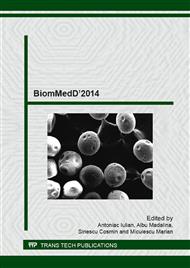p.54
p.62
p.67
p.73
p.79
p.85
p.91
p.98
p.104
XRD and Microstructural Analyses on Biodegradable Mg Alloys
Abstract:
Stainless steels, titanium and titanium alloys are the most widely used artificial surgical biomaterials for a long time. These alloys with non-degradability properties present long-term adverse effects or stress shielding and require a second surgery for a complete healing. The ongoing scientific research to avoid this problem found a new kind of biocompatible alloys for implants made of biodegradable materials witch should be used as alternative. Among the various biodegradable materials, magnesium alloys have unique biodegradability properties in the physiological environment, have stimulatory effects on new bone formation and have an elastic modulus similar to that of human bone. Roentgen structural analysis was used to detail the global chemical composition analysis, especially the analysis to determine the phase-pick sites characteristic diffraction and crystallographic orientation parameters Miller constituent phases. On studied alloys Mg and Mg2Ca type compounds with different crystallographic orientations were identified. The results obtained on the Mg-Ca and Mg-Ca-Si systems will be correlated with results from previous tests and analyses, to finally obtain an alloy with biodegradability that may be controlled.
Info:
Periodical:
Pages:
79-84
Citation:
Online since:
March 2015
Keywords:
Price:
Сopyright:
© 2015 Trans Tech Publications Ltd. All Rights Reserved
Share:
Citation:


